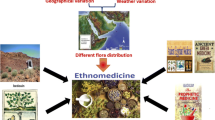Abstract
Economic Botany 58(Supplement):S221–S229, 2004. This paper reports the use of Brugmansia species (Solanaceae) in traditional practices of shamans (curanderos) of Northern Peruvian Andes. The field study permitted the classification of a number of species and/or their hybrids used for both curative and psychotropic activities. There is evidence of a folk systematics in this genus that constitutes a very important phenomenon for its therapeutic-divinatory, phytotherapeutical, and ritual (in initiation and black magic rites) uses.
Similar content being viewed by others
Literature Cited
Agurell, S. 1969. Cactaceae alkaloids. Lloydia 32: 206–216.
Bianchi, A., and G. Samorini. 1993. Plants in association with ayahuasca. Jahrbuch für Etnomedizin 1993:21–42.
Bristol, L. M. 1966. Notes on the species of tree daturas. Botanical Museum Leaflets, Harvard University 21:229–248.
Bristol, L. M. 1969. Tree Datura drugs of the Colombian Sibundoy. Botanical Museum Leaflets, Harvard University 22:165–227.
Brown, J. H., and P. Taylor. 2001. Muscarinic receptors agonists and antagonists. Pages 155–174 in J. G. Hardman, L. E. Limbird, and A. Goodman Gilman, Goodman and Gilman’s The pharmacological basis of therapeutics, 10 ed. McGraw-Hill, New York.
Cabieses Molina, F. 1990. The magic plants of ancient Peru. Atti del V Congresso Nazionale della Società Italiana di Fitochimica, Ischia, 30 maggio-2 giugno 1990, LP2.
De Feo, V. 1992. Medicinal and magical plants on Northern Peruvian Andes. Fitoterapia 63:417–440.
— 2003. Ethnomedical field study in Northern Peruvian Andes with particular reference to divination practices. Journal of Ethnopharmacology 85: 243–256, and references cited therein.
—, A. Capasso, F. De Simone, and C. Pizza. 2002. Ethnobotany and the search of new drugs: Some psychoactive plants in the folkloric medicine of the northern Peruvian Andes. Acta Phytotherapeutica l(3rd series): 10–25.
Diaz, J. L. 1979. Ethnopharmacology and ethnopharmacognosy of Mexican psychodysleptic plants. Journal of Psychedelic Drugs 11:71–101.
Evans, W. C. 1979. Tropane alkaloids of the Solanaceae. Pages 241–254 in J. G. Hawkes, R. N. Lester and A. D. Skelding, eds., The biology and taxonomy of the Solanaceae. Academic Press, New York.
Friedberg, C. 1959. Rapport sommaire d’une mission au Pérou. Journal d’Agriculture Tropicale et de Botanique appliquée 6:439–450.
— 1963. Mission au Pérou. Mai 1961-mars 1962. Journal d’Agricolture Tropicale et de Botanique appliquée 10:32–52, 234–258, 344–386.
Furst, P., ed. 1972. Flesh of the gods, the ritual use of hallucinogens. Praeger, New York.
Girault, L. 1984. Kallawaya, Guérisseurs Itinérants des Andes. Editions de l’Orstom, Paris.
Harner, M. J. 1972. The Jívaro: People of the sacred waterfalls. Doubleday/Natural History Press, New York.
Hunziker, T. A. 1979. South-American Solanaceae: A synoptic survey. Pages 49–85 in J. G. Hawkes, R. N. Lester, and A. D. Shelding, eds., The biology and taxonomy of Solanaceae. Linnean Society Symposia Series no. 7. Academic Press, London.
La Barre, W. 1972. Hallucinogens and the shamanistic origin of religion. Page 261–278 in P. Furst, ed., Flesh of the gods, the ritual use of hallucinogens. Praeger, New York.
Lockwood, T. E. 1973. Generic recognition of Brugmansia. Botanical Museum Leaflets, Harvard University 23:273–281.
Lockwood, T. E. 1976. Systematics of the genus Brugmansia. Abstracts of International Symposium on Biology and Taxonomy of Solanaceae. Abstracts of papers: 54–55. Birmingham University.
— 1979. The ethnobotany of Brugmansia. Journal of Ethnopharmacology 1:147–164.
McKenna, D. J., L. E. Luna, and C. H. N. Towers. 1986. Ingredientes biodinamicos en las plantas que se mezclan al ayahuasca. Una farmacopea tradicional no identificada. America Indigena 46:73–98.
McLaughlin, J. L. 1973. Peyote: An introduction. Lloydia 36:1–8.
Muller, J. L. 1998. Witch ointments and aphrodisiacs. A contribution to the cultural history of nightshade plants. Gesnerus 55:205–220.
Poisson, J. 1969. The presence of mescaline in a Peruvian cactus. Annales Pharmaceutiques Françaises 18:764–765.
Polia, M. 1987. Glosario del Curanderismo Andino del Departamento de Piura. Anthropologica 6:177–238.
Polia, M. 1988. Las lagunas de los Encantos—medicina tradicional andina del Peru septentrional. CePeCer, Lima, and references cited therein.
Quesada, C. 1976. Diccionario Quechua Cajamarca-Cañaris. Lima.
Rivier, L., and J. E. Lindgren. 1972. Ayahuasca, the South American hallucinogenic drink: An ethnobotanical and chemical investigation. Economic Botany 26:101–129.
Schultes, R. E. 1955. A new narcotic genus from the Amazon slope of the Colombian Andes. Botanical Museum Leaflets, Harvard University 17:1–11.
— 1963a. Hallucinogenic plants of the New World. Harvard Review 1:18–32.
— 1963b. Botanical sources of the New World narcotics. Psychedelic Review 1:145–146.
— 1970. The plant kingdom and hallucinogens. Bulletin of Narcotics 22:25–53.
— 1972a. An overview of hallucinogens in the Western hemisphere. Pages 3–54 in P. Fürst, ed., Flesh of the gods: The ritual use of hallucinogens. Praeger, New York.
— 1972b. De Planus Toxicariis e Mundo Novo Commentationes. X. New data on the Malpighiaceous narcotics of South America. Botanical Museum Leaflets, Harvard University 23:137–147.
— 1972c. De Planus toxicariis ed Mundo Novo commentationes. XI. The ethnobotanical significance of additives to New World hallucinogens. Plant Science Bulletin 18:34–41.
— 1972d. The utilization of hallucinogens in primitive societies, use, misure or abuse? Pages 17–27 in W. Keup, ed., Drug abuse. Charles C. Thomas, Springfield, IL.
— 1979. Solanaceous hallucinogens and their role in the development of the New World cultures. Pages 137–60 in J. G. Hawkes, R. N. Lester, and A. D. Shelding, eds., The biology and taxonomy of Solanaceae. Linnean Society Symposia Series no. 7. Academic Press, London, and references cited therein.
—, and A. Hofmann. 1973. The botany and chemistry of hallucinogens. Charles C. Thompson, Springfield, IL.
Shulgin, A. T. 1979. Chemistry of phenetylamines related to mescaline. Journal of Psychedelic Drugs 11:41–52.
Smith, T. A. 1977. Phenethylamine and related compounds in plants. Phytochemistry 16:9–18.
Tschudi, J. D. 1846. Peru: Reisenskizzen aus den Jahren 1832–1842. Vol. 2, 21–23, St. Gallen.
Wilkinson, J. A. 1987. Side effects of transdermal scopolamine. Journal of Emergency Medicine 5: 387–392.
Ziskind, A. A. 1988. Transdermal scopolamine-induced psychosis. Postgraduate Medicine 84:73–76.
Author information
Authors and Affiliations
Rights and permissions
About this article
Cite this article
De Feo, V. The ritual use of Brugmansia species in traditional Andean medicine in Northern Peru. Econ Bot 58 (Suppl 1), S221–S229 (2004). https://doi.org/10.1663/0013-0001(2004)58[S221:TRUOBS]2.0.CO;2
Received:
Accepted:
Issue Date:
DOI: https://doi.org/10.1663/0013-0001(2004)58[S221:TRUOBS]2.0.CO;2




